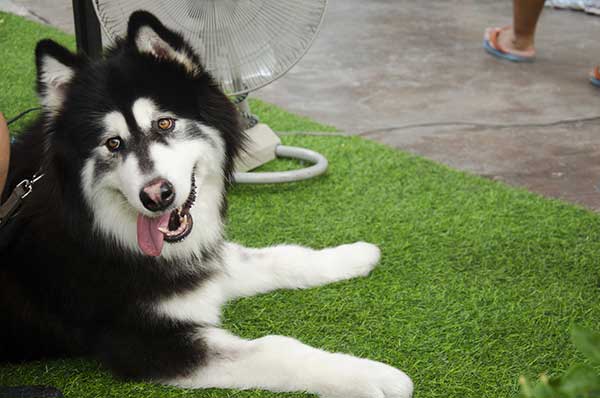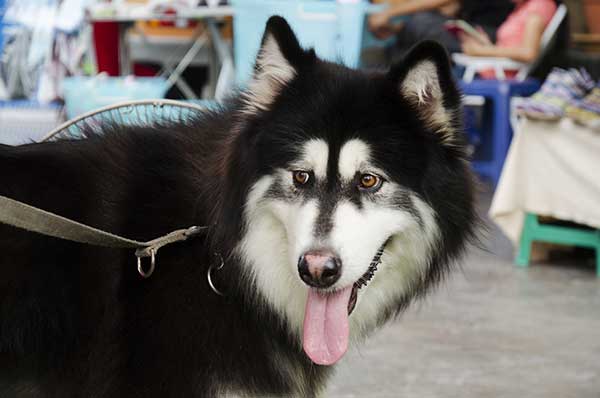The Giant Alaskan Malamute is an extra-large Alaskan Malamute.
Unlike the Alaskan Malamute, the Giant Alaskan Malamutes are not recognized by the American Kennel Club as a unique breed. This is simply because the Giant Alaskan Malamute is just an Alaskan Malamute that has been bred for its size rather than temperament.
In this comprehensive guide to the Giant Alaskan Malamute, we’ll take a look at their size, personality traits, training, health and more, so you can determine if these oversized dogs can make a good addition to your family.
What Is A Giant Malamute?
Giant Alaskan Malamutes are selectively bred Alaskan Malamutes that weigh over 100 pounds.
Giant Alaskan Malamutes were originally developed to help pull very heavy loads across Alaska. These oversized Malamutes have been documented to pull goods weighing over 1,000 pounds!
Their average height exceeds 35 inches, and they generally look like a cross between a bear and a wolf.
Nonetheless, Giant Alaskan Malamutes are not a different breed from the Alaskan Malamute. As we’ve already mentioned, these are just Alaskan Malamutes that have been selectively bred for their size. This often puts their heath at great risk.
The Giant Alaskan Malamute is sometimes confused for a Siberian Husky. Although they look similar, they differ in a number of ways.
However, the main difference is their size. While Alaskan Malamutes weigh around 65 to 85 pounds and Siberian Huskies 35 to 60 pounds, Giant Alaskan Malamutes typically weigh over 100 pounds.
The Origin of the Alaskan Malamute Breed
The origin of the Giant Alaskan Malamute and the Alaskan Malamute is shrouded in mystery. However, it is believed that the Inuit people used these dogs to pull sleds in the 18th century. Back then, these canines were considered to be working dogs, and not family dogs.
Their strength and endurance made them great working dogs. With the discovery of gold in Alaska some time in 1896, the popularity of the breed skyrocketed. They were commonly used to pull heavy loads of gold throughout the city.
However, Giant Malamutes were not used for racing. Instead, they were used for breeding racing dogs like Huskies.
Another thing that contributed to their popularity was the serum run. You may have heard about the heroics of Balto, the famous dog who delivered medicine to Nome to help combat a diphtheria outbreak. Many teams of canines were used and many of them included Alaskan Malamutes.
ALSO READ: Alaskan Malamute Vs Siberian Husky: What’s the Difference?
Physical Appearance
Since the Giant Alaskan Malamute was bred in cold climates, these dogs have a coarse overcoat and a soft undercoat for protection against the harsh weather elements.
The dogs are mainly black, grey and black and have white markings on their head, muzzle or face. Their ears tend to be small and straight.
Unlike the Siberian husky (which have blue eyes), Alaskan Malamutes have amber brown eyes.

How Big Is a Giant Alaskan Malamute?
When it comes to the Giant Alaskan Malamute size, these oversized dogs can grow to reach over 150 pounds. The dogs are slightly taller than their female counterparts at about 30 inches.
Since Giant Alaskan Malamutes are not officially recognized by the American Kennel Club, there is no breed standard for them.
It is important to realize that these oversized dogs are not a breed on their own. Instead, they are Alaskan Malamutes that have been bred for their size as opposed to aspects like temperament, type, structure and health.
Coat and Colors
The Giant Malamute has a long and dense double coat. The undercoat is very thick and woolly in texture. They have a coarse overcoat that is around once inch long. This helps to keep them warm during extreme winter conditions.
Giant Malamutes also shed a lot and will require regular brushing. These dogs tend to blow their coat twice a year and will require daily brushing.
They come in a range of colors, such as white, solid white, black, gray, sable, seal, chocolate and red.
Giant Alaskan Malamute Temperament
The Giant Alaskan Malamute is a spirited dog who enjoys physical activities. However, these dogs are also very affectionate and loyal to their owners.
Alaskan Malamutes are also very intelligent dogs, but they can also be very stubborn, so early training is very important.
They can be great escape artists, so a secure, fenced-in yard is essential. They are extremely curious and they enjoy taking things apart.
Another natural trait that you should be aware of is food aggression. This is something that enabled their ancestors to thrive in the wild.
Due to this territorial behavior and their sheer size, Giant Alaskan Malamutes may not be a good choice for families with small kids. It takes just a few moments for a curious child to grab the dogs feeding bowl for an accident to occur.
Due to the size and strength of this dog, small kids can be easily knocked down by a Giant Malamute.
For smaller pets such as cats, an Alaskan Malamute may want to chase them around as they are naturally fond of chasing and hunting small animals. They may also attack other dogs to assume the role of pack leader.
Even properly trained canines can run over long distances due to their genetic predisposition. The best way to keep your Giant Malamute healthy and happy is to give him ample opportunities to exercise and run around.
Are Giant Alaskan Malamutes Good Family Dogs?
Yes. Giant Alaskan Malamutes have the potential to be good family pets. They do better with older children or teenagers. Nonetheless, they should be closely monitored due to their power and size.
These dogs might not do well in homes with small pets. They are very protective of their territory and can be aggressive towards strangers, whether they are people or other animals.
As a giant breed, this dog is not a good apartment dog. Due to their large size, these dogs will do much better in large homes with gardens or yards where they can run and move freely so they can remain happy.
Training
As we’ve mentioned above, Alaskan Malamutes are very intelligent and stubborn, so training can be a challenging task. Nonetheless, the following tips can help make training a lot easier.
Use positive reinforcements: Giant Alaskan Malamutes will not respond well to cruel or harsh treatment during training. Instead, they enjoy playing and eating. Treats, praise and other positive reinforcement methods will go a long way towards instilling good behavior.
Be careful not to overdo things, especially when it comes to food rewards: although you need to use positive reinforcements during training, just make sure you do not overdo it, or else you could end up with an overweight dog. This could result in a number of health problems.
Socialization is vital: Giant Malamutes can be dominant towards other canines, and can attack other animals. Therefore, it’s extremely important to socialize your Giant Malamute from a young age. Expose them to other humans, animals and situations in monitored environments, and don’t hesitate to get them a professional trainer if need be.
Exercise Needs
The Giant Malamute won’t do well locked in an apartment. These dogs will need a large home with a sizable yard for them to move freely.
Moreover, several walks each day and regular trips to the dog park are recommended to keep these dogs strong and happy. If a Malamute does not receive sufficient exercise, he will howl constantly and become a nuisance to your neighbors.
The best way to keep this dog exercised is to take him out on hikes or runs. Ideally, these dogs require exercises that will stimulate their body as well as their mind. If their exercise needs are not met, owners should expect a dog that howls and chews constantly.
ALSO READ: The Top 20 Best Puzzle Toys For Your Bored Dog
Grooming
The Giant Alaskan Malamute has a very thick double coat that requires daily brushing.
As we’ve already mentioned, Malamutes tend to shed a lot. Therefore, make sure to brush them regularly, and invest in a high-quality vacuum cleaner to make the task of picking up pet hair easier for you.
Malamutes also require regular bathing, at least once every 6 to 8 weeks. Your pooch will look more beautiful, smell nicer and it will help reduce the shedding if your groom him regularly.
Alaskan Malamutes are also prone to dental issues, so make sure to brush their teeth at least 3 times per week.
Additionally, clean their ears each week and keep their nails sort by clipping them when necessary.
Feeding Guide
Alaskan Malamutes need to eat at least three cups of high quality dog food each day. You should divide his meals into two by feeding him in the morning and evening. However, the amount of food your dog needs will depend on his age, size and activity level.
If your pup constantly performs strenuous tasks, then his regular diet should be made up of at least 22 percent protein.
How Long Does A Giant Alaskan Malamute Live?
Giant Alaskan Malamutes have an average lifespan of around 8 to 12 years.
A healthy diet is extremely important. Moreover, taking your pooch to the vet for periodic checkups can help detect any health issues in their early stages.
Make sure your Malamute gets enough exercise in order to maintain a healthy weight.
Giant Alaskan Malamute Health Problems
The Giant Malamute is a fairly healthy breed. However, there are a few health issues you should be aware of if you’re considering getting this dog.
The main concern for any dog this huge is their joints. Most large breeds are prone to hip dysplasia, but it is believed to be quite rare in the Alaskan Malamute. However, it’s still important to be cautious when exercising them.
Their temperature is another area you want to pay attention to since their thick coats do not tolerate heat well.
A few other health conditions that are quite common among Malamutes include arthritis, progressive retinal atrophy and von Willebrand disease.
Finding a reputable breeder is vital to avoiding such health problems.
How Much Is A Giant Alaskan Malamute?
The price of a Giant Alaskan Malamute puppy for sale can vary significantly, with some purebred pups going for up to $2,000 or even $6,500.
If you really want a Giant Malamute, then you should prepare to pay a higher price. Higher priced Giant Alaskan Malamute puppies will come from working bloodlines and health-tested parents.
A litter usually has around 4 to 8 puppies. Reputable breeders should be able to match you and a healthy puppy depending on their temperament and your lifestyle.
Make sure a puppy is at least 8 weeks old before taking them home. The puppy should have had its first vaccinations before being adopted. When you meet the parent dogs, it’s important to know if the puppies have been health-screened.
Alaskan Malamute puppies grow very fast but don’t attain their adult size until almost 3 years of age.
It’s also important to ensure their joints are healthy and not over-exercised during their growing stage. You should keep long walks or runs to a minimum and avoid encouraging them to jump too much or too high. That can put a lot of strain on their joints and cause permanent joint problems.
Adoption
It is difficult to find the Giant Malamute in a shelter. This is because there are no groups dedicated to the adoption of the giant version of the Alaskan Malamute.
However, you can visit Alaskan Malamute rescue groups like the Moonsong Malamute Rescue and see if there are any giant variations available for adoption.
ALSO READ: Everything You Need to Know About the Alusky
Conclusion
As we’ve mentioned, the Giant Alaskan Malamute is not a breed on its own. Instead, these dogs are basically Alaskan Malamutes that have been developed with size in mind rather than various other traits such as temperament, structure for health.
The ideal living environment for the dogs is a home where the family members have the time to exercise them regularly, including taking them out on daily walks and hikes.
If you’re thinking of getting these dogs, then you should have the time to train, socialize and exercise them.





